A crowd pressed into the small Qbix Gallery Friday night to witness artist Rah Crawford destroy three of four pieces he promised to saw through if they didn’t sell. The gallery had some yellow caution tape across its width, behind which stood two saw horses. Crawford called the show Deus Ex Machina.
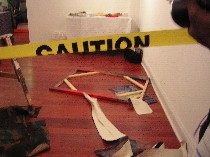
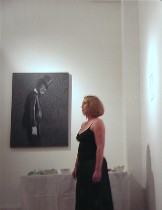
A classical singer was singing some very sad music when I arrived at 11:30 p.m.: something appropriate for a funeral. (Murray helped me stay upright; it was past my bedtime). That’s the soprano, way in the back right corner of the gallery.
When she was done, Crawford, a good-looking young man dressed in a black muscle shirt with the word “human” on the front, took the paintings out of their frames. He barely looked at the crowd, and seemed quite preoccupied and angry. I don’t know that he really thought he’d have to go ahead and destroy this many pieces (one was guaranteed to go under the saw, but three?).
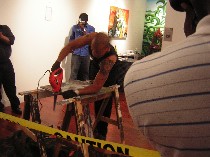
Then he set one of the board paintings on the sawhorses, fired up the orange saw and set to work.
It wasn’t so easy. Besides the way he had to steel himself for the job, he could barely hold on to the panel, which kept jumping around and skittering away from the saw. Crawford slammed the saw horses back together; they too had moved some. All I could think of was I hoped he wouldn’t hurt himself. These were not what I’d call safe sawing practices. When he completed the first act of destruction, one man in the gallery clapped, but Crawford asked people not to applaud.
After the first painting finally came apart, Crawford grabbed a box cutter and cut the canvas painting into ribbons. Finally, he grabbed the last painting, also on panel, and laid it on the sawhorses. The saw would not cut through it. Crawford was angry.
Not a very festive evening
Through all this, most of the crowd looked rather stricken and sad. When Crawford failed with number three, he asked the crowd if he should keep trying. It was more thumbs up than down, and one couple said they’d buy it. The deus ex machina (which was the name of the show) turned out to be the machina, indeed, the saw that wouldn’t saw right.
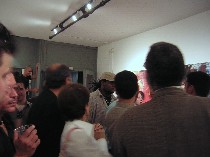
After the rescue of the third painting came some applause, but lots of people held back and just seemed sad and thoughtful. Sharon and Sharon (the Qbix gallerists are a man and woman both named Sharon) were subdued, too.
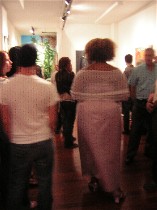
Another soprano, in a gown, walked slowly toward the back of the gallery, also singing a minor-key composition. People started to leave. (The one painting of the original four originally slated for possible destruction that was bought prior to the evening drama was “Last Ride,” said Sharon, the woman.)
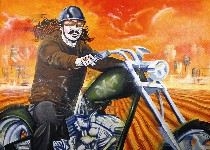
“Last Ride” has the hallmarks of what I think is most interesting in Crawford’s work, so I was glad that it wasn’t one of the ones on the block. It has graffiti and hip-hop influences, commercial art influences, language all over the place, an apocalyptic take on our urban spaces. Not all of Crawford’s work feels fully cooked yet, but I think he’s a pretty interesting guy and I hope this experience doesn’t cool him on art. I think he has something to say.
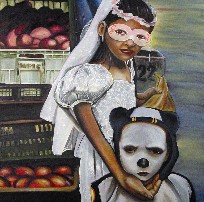
The one that survived the carnage was “Mr. & Mrs. Bear”.
The Greek drama really did take on some feeling of something important lost, and raised questions about the value of art. I’d say, with the thumbs-up response, some of the crowd, at least, thought Crawford’s work was worth saving and protecting.
I found it interesting that Crawford, who in a way seemed to be challenging art’s value at the same time that he was challenging collectors to step up to the plate and buy, clearly found the loss of his darlings to be difficult and sad. The performance was not so much a performance as a ritual. And the name of his show seemed pretty perfect after all.









